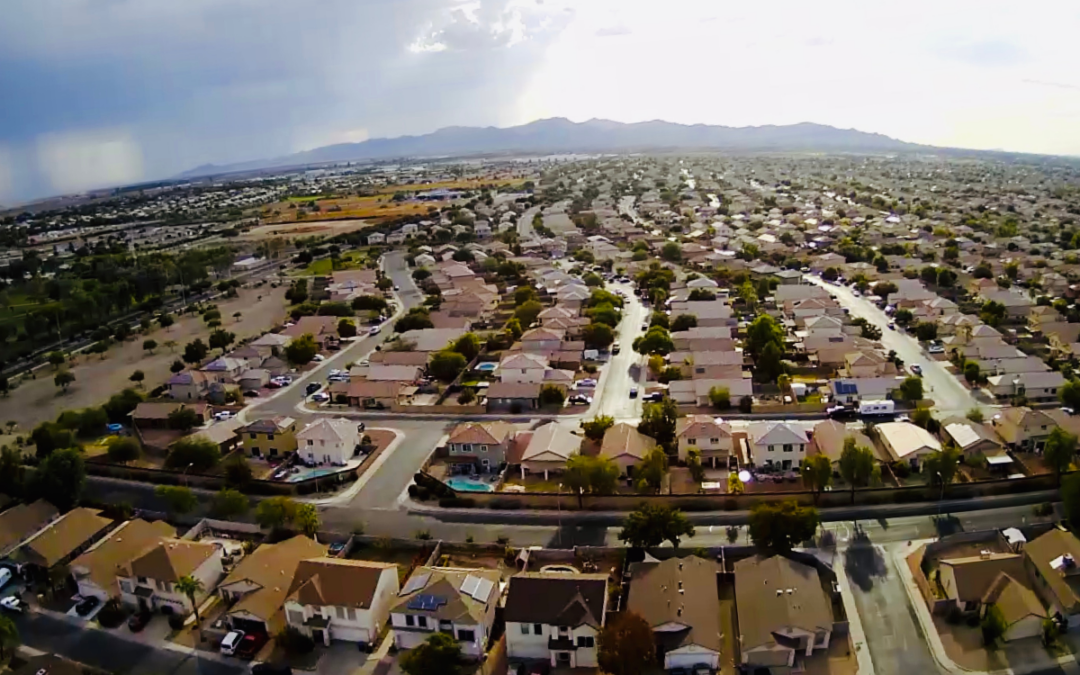While online classes may not be a big deal to most Arizona students, many are forced to resort to paper packets or track down places where they can get internet access.
Cassandra Hovey has a lot of responsibilities during this pandemic. She is juggling college classes while trying to get the three school-age children in her home to complete their work and keep her family healthy. But one thing she doesn’t have is home internet access.
Hovey and her family live in Bowie, an unincorporated community about an hour and a half’s drive east of Tucson.
“Internet access is very slim pickings for us at home,” Hovey told The Copper Courier. “And then we have limited hotspot to use as well when we’re at home, so we have to go places to find access to internet. And the library’s closed, so you can’t go to the library now.”
RELATED: I’m an Educator, Mom, and Grandma. And I’m Here to Help Arizona Parents Keep Kids Educated Amidst Coronavirus.
To complete their online work, Hovey and the children go to a conference room at a nearby school where their district superintendent has set up a spot for them and other families to access Wi-Fi.
While Hovey said that although this arrangement is very helpful, she still considered dropping out of her early childhood education classes at Cochise College due to all the stress.
“I was so flustered when all this first broke out that I almost threw my hands in the air and walked away from college altogether for a while,” she said.
But, ultimately, she said she knew her husband believed in her, and she didn’t want to disappoint him as she worked toward becoming a teacher or paraprofessional.
Students Without Internet Falling Further Behind
According to Dr. Melissa Sadorf, superintendent of the Stanfield Elementary School District, the Hoveys’ story is not unique.
At her schools, which are about an hour’s drive south of Phoenix, only 73 out of 450 students (500 including preschool) have internet access at home. This means less than 20% of her students could easily complete online work.
Christine Thompson, the president of education advocacy group, Expect More Arizona, said the number of students without internet access will likely increase during the pandemic due to families’ financial difficulties.
“Somebody might have Wi-Fi or internet today,” she told The Copper Courier. “But if they lose their job that might be something that gets dropped relatively quickly in order to make sure that they can pay for food and shelter.”
RELATED: Three UArizona Students Tell Us How Coronavirus Derailed Their Lives
Sadorf said because so few kids have internet access, the district has been focusing on providing students with paper packets, which are dropped off to the students each week along with meals.
“That’s been the easiest low-tech way to keep some kind of learning opportunities available to our students,” she said.
Sadorf said while the district has enough laptops to give to students to take home, what it doesn’t have is a way to connect them to the internet.
“The issue has been finding hotspots,” she said. “They’re several weeks on backorder. So even if we were able to purchase them, we’re almost at the end of school by the time they’d get them.”
Gov. Doug Ducey announced last week that the state is holding a drive to collect these hotspots and will start by handing out 200. But his office has yet to announce who will receive those hotspots and when.
In some school districts where a vast majority of students do have internet access, classes can continue almost normally. But students like Sadorf’s are stalled in their learning. The superintendent said her district has held off on teaching new concepts to kids in younger grades.
“What are we going to do at the beginning of next year when we have four quarters worth of standards that we need to make sure that students are familiar and master, knowing that we have yet still a fifth quarter of learning that they need to have on top of that?” she said.
Thompson said the pandemic will increase the achievement gap between students with varying levels of resources.
“Every student is going to have some slide because of this pandemic and closing of schools,” she said. “But what we do know is there are going to be some students who don’t slide as far as others, and there are going to be another set of students who are even further behind than they started out behind because of the challenges that they have and their families have during this crisis.”
School Isn’t Just About Learning
Sadorf said while she is concerned about her students falling behind on their learning, worrying about the wellbeing of students they haven’t been able to contact since schools closed is what keeps her up at night.
“We do have students [who] live in crisis,” she said. “We are not able to connect with them in the same way when they’re at home all of the time and we don’t have that daily contact with a caring adult.”
Sadorf said she also worries about students who are dealing with anxiety and can’t access professional help.
“We are 600 square miles of rural area, and there really isn’t any support systems outside of the school for these families to go to to get any kind of support for those kinds of [social-emotional] needs,” she said.
RELATED: This Is How Teachers Show Love During Coronavirus
And while students are missing out on educational opportunities, they’re also missing out on crucial time spent developing social skills.
“That character education, that community building, the opportunity to develop lasting and caring relationships … [are] hugely, hugely important and a critical loss for these kids as we finish out the year, really, after spring break,” Sadorf said.
Due to the pandemic, some students don’t get to experience milestones like prom and graduation. Hovey said her 18-year-old relative who lives with her, a high school senior, has been “struggling” with the fact that she doesn’t get to walk on stage with her fellow classmates. But Hovey said she has promised her they will make up for it when the pandemic has subsided and things go back to normal.
Pandemic Shows Digital Divide Is a Crisis
Education experts say if there’s a silver lining to the pandemic, it’s that it has brought the issue of the digital divide to the forefront.
“This has really forced the issue,” Sadorf said. “Before it was a topic of conversation. Now it’s a crisis.”
Thompson said before the pandemic, data about how many students had internet access and computers at home was scarce. But now that information is coming together.
“We haven’t really been able to get to that granular a level of what students have access to physical hardware or Wi-Fi before, and now schools across the state are asking students that very question,” she said.
“We’ve been talking about this digital divide for 15 years, and I think that this pandemic is going to put a fine point on it and give us information that we’ve never had before,” Thompson added.
While Arizona schools are definitely going to be closed through the end of this school year, there’s still a lot of uncertainty about when students will be able to return to class. Sadorf said it’s “frightening” to think schools could possibly not reopen by the fall, and she and her teachers are trying to find ways to be ready in case that happens.
RELATED: Arizona Schools Are Closing. Experts Explain How This Could Have Been Avoided
“[We’re asking ourselves] what can we do between now and August … to ensure that we’re able to connect with them, if not face-to-face, in a virtual way and ensure that all of our students have what they need in order to make that happen,” Sadorf said.
And Thompson said it’s important to have a plan in place for what will happen when in-person classes are back in session.
“When we look to next year and when schools reopen, we need to both try and support kids the best we can right now with the limitations that we have,” she said. “But then once we get everybody physically back in school, how do we make sure we’re wrapping ourselves around all those students to get them back up where they should have been at the end of a regular school year, and even prepared to accelerate even faster for the next school year?”
Although things have been difficult lately, Hovey said she is determined to finish her classes and the children in her care on track with their schoolwork.
“It has been hard,” she said, “but I’m doing my best.”
Looking for the latest Arizona news in this time of crisis? Sign up for our daily newsletter and have it delivered straight to your inbox.
Politics

The Republican war on Medicare raises the stakes in 2024
More than 1.5 million Arizonans rely on Medicare benefits—benefits they spent decades paying into, with the promise that the program would be there...

Roaming billboard targets Rep. Schweikert’s votes that ‘could outlaw IVF’
Arizonans from Phoenix to Fountain Hills had their usual view of palm trees and blue skies obscured Wednesday by a reminder that their congressional...
Local News

Biden announces new action to address gun sale loopholes
The Biden administration on Thursday announced new action to crack down on the sale of firearms without background checks and prevent the illegal...

Maricopa County, El Mirage partner to make 5 homes more affordable
The Maricopa County Board of Supervisors and city of El Mirage approved an agreement to make a handful of homes in the city more affordable. El...





